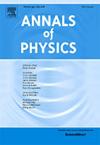从谐波阱到光学晶格:准一维相互作用玻色气体的绝热载荷
IF 3
3区 物理与天体物理
Q2 PHYSICS, MULTIDISCIPLINARY
引用次数: 0
摘要
光学晶格中的超冷原子为研究不同的量子相提供了一个高度可控的平台。在三维空间中,玻色气体在临界温度Tc以下表现出玻色-爱因斯坦凝聚(BEC),而在光学晶格中,在零温度下出现超流体-莫特绝缘体跃迁。相比之下,准一维捕获玻色气体在热力学极限下不会表现出真正的凝聚,但可以表现出有限尺寸的凝聚特征,并且已经通过实验进行了测试。在这项工作中,我们研究了最初在准bec相制备的谐波捕获的准1d玻色气体在具有约束诱导共振(CIR)相互作用的光学晶格中的绝热载荷。通过将热力学Bethe ansatz与晶格声子模型(其声子谱由离散非线性Schrödinger方程(DNLSE)获得)相结合,我们研究了相互作用强度和晶格深度如何共同影响绝热加载过程。特别地,我们分析了所得到的最终温度Tf和表征光学晶格中平衡态的最可能的位置占用数nL *。我们发现,当填充不固定时,由于熵重分布,Tf通常超过初始温度Ti。至关重要的是,我们发现超流动性的损失不仅仅是由通常假设的现场相互作用引起的,而且还受到相互作用诱导的隧道效应的强烈影响。当这个项在强耦合下变得明显时,它会引起动力学不稳定性,即使在先前认为稳定的状态下也会破坏超流体相。我们的研究结果阐明了组合晶格势和原子间相互作用如何塑造低维超冷原子系统的热力学行为和稳定性。本文章由计算机程序翻译,如有差异,请以英文原文为准。
From harmonic trap to optical lattice: Adiabatic loading of a quasi-one-dimensional interacting Bose gas
Ultracold atoms in optical lattices offer a highly controllable platform for studying diverse quantum phases. In three dimensions, Bose gases exhibit Bose–Einstein condensation (BEC) below a critical temperature , while in optical lattices, a superfluid–Mott insulator transition emerges at zero temperature. In contrast, quasi-one-dimensional (quasi-1D) trapped Bose gases do not exhibit true condensation in the thermodynamic limit but can display finite-size condensate features and have been tested by experiments. In this work, we investigate the adiabatic loading of a harmonically trapped quasi-1D Bose gas initially prepared in the quasi-BEC phase into an optical lattice with confinement-induced resonance (CIR) interactions. By combining the thermodynamic Bethe ansatz with a lattice phonon model — whose phonon spectrum is obtained from the discrete nonlinear Schrödinger equation (DNLSE) — we investigate how interaction strength and lattice depth jointly influence the adiabatic loading process. In particular, we analyze the resulting final temperature and the most probable site occupation number that characterize the equilibrium state in the optical lattice. We find that generally exceeds the initial temperature due to entropy redistribution when the filling is not fixed. Crucially, we identify that the loss of superfluidity is not solely caused by on-site interactions, as usually assumed, but is also strongly influenced by interaction-induced tunneling. As this term becomes appreciable at strong coupling, it induces dynamical instabilities that can destroy the superfluid phase even in regimes previously deemed stable. Our results clarify how combined lattice potentials and interatomic interactions shape the thermodynamic behavior and stability of ultracold atomic systems in low dimensions.
求助全文
通过发布文献求助,成功后即可免费获取论文全文。
去求助
来源期刊

Annals of Physics
物理-物理:综合
CiteScore
5.30
自引率
3.30%
发文量
211
审稿时长
47 days
期刊介绍:
Annals of Physics presents original work in all areas of basic theoretic physics research. Ideas are developed and fully explored, and thorough treatment is given to first principles and ultimate applications. Annals of Physics emphasizes clarity and intelligibility in the articles it publishes, thus making them as accessible as possible. Readers familiar with recent developments in the field are provided with sufficient detail and background to follow the arguments and understand their significance.
The Editors of the journal cover all fields of theoretical physics. Articles published in the journal are typically longer than 20 pages.
 求助内容:
求助内容: 应助结果提醒方式:
应助结果提醒方式:


